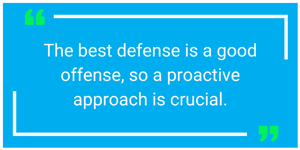
In today's technology-driven world, IT security risk management has become a top priority for businesses of all sizes. Cyberattacks continue to pose a significant threat to businesses, making it critical for organizations to take proactive measures to identify vulnerabilities and implement appropriate safeguards. One such measure is external vulnerability scanning, which is central to any good IT security risk management program.
What is Vulnerability Scanning?
Continuous vulnerability scanning is a proactive measure that focuses on preventing security breaches before they become a threat. Critical network vulnerabilities can result in serious problems ranging from data breaches to compliance failures. In sports, as in IT security, the best defense is a good offense, meaning a proactive approach is crucial.
The first step towards implementing regular vulnerability scanning is building an updated inventory of systems connected to your network. This includes physical endpoints, such as laptops, servers, and desktops, as well as software-based resources like virtual machines, cloud apps, and storage. The inventory should also cover networking hardware and systems, such as routers, switches, and firewalls.
The vulnerability scanner will then identify and monitor every system, including which operating system is running, which ports are open, and which user accounts are accessing it. Being an event-based measure, vulnerability scanners attempt to log into systems using default or other credentials to provide maximum visibility into your network and security posture.
Finally, the system will check every item in the inventory against databases of known vulnerabilities. With the assistance of a managed services provider (MSP), this process will be augmented by expert manual review, as well as cutting-edge solutions involving AI and machine learning.
Why External Vulnerability Scanning Is Critical to IT Security Risk Management
Maintains Compliance
One of the most significant benefits of external vulnerability scanning is that it helps organizations maintain broad-scale compliance with industry standards and regulations. For instance, the SOC 2 (System and Organization Controls 2)-1.png?width=320&height=268&name=achieve%20soc%202%20compliance%20w%20EVS%20(1)-1.png) framework is a standard for IT service providers and other businesses that store customer data in the cloud. SOC 2 compliance requires regular external vulnerability scans to ensure that the organization's systems are secure and meet specific security requirements.
framework is a standard for IT service providers and other businesses that store customer data in the cloud. SOC 2 compliance requires regular external vulnerability scans to ensure that the organization's systems are secure and meet specific security requirements.
In addition to SOC 2 compliance, external vulnerability scanning also helps with SEC compliance. The SEC (Securities and Exchange Commission) requires public companies to disclose material cybersecurity risks and incidents in their annual filings. By conducting regular external vulnerability scans, organizations can identify potential risks and take proactive measures to address them, reducing the likelihood of cybersecurity incidents that could result in SEC disclosure obligations.
|
Related article: IT Budgeting Best Practices: Include A Vulnerability Scanning Program |
Proactive Cybersecurity Approach
The costs of a serious data breach can easily run into hundreds of thousands or even millions of dollars. According to a 2022 report published by IBM, the average cost of a data breach in the United States is 9.44 million dollars. Beyond compliance, implementing an external vulnerability scanning program offers numerous business benefits. For instance, it helps organizations reduce costs associated with cyberattacks by identifying and addressing vulnerabilities before they can be exploited. Moreover, it enables organizations to stay ahead of cyberthreats by regularly identifying and addressing potential risks.
average cost of a data breach in the United States is 9.44 million dollars. Beyond compliance, implementing an external vulnerability scanning program offers numerous business benefits. For instance, it helps organizations reduce costs associated with cyberattacks by identifying and addressing vulnerabilities before they can be exploited. Moreover, it enables organizations to stay ahead of cyberthreats by regularly identifying and addressing potential risks.
Prioritization of Security Investments
External Vulnerability Scanning plays a vital role in prioritizing security investments in terms of cybersecurity risk management. By conducting regular scans, organizations can identify and prioritize vulnerabilities based on their severity and potential impact. This enables organizations to allocate resources effectively and prioritize security investments based on the most critical vulnerabilities. For example, if an external vulnerability scan reveals a critical vulnerability in a system or application, the organization can allocate resources to address that vulnerability before focusing on less critical ones. As a result, the organization can reduce the likelihood of a cyberattack and minimize the potential impact on their systems and data. By prioritizing security investments based on the results of external vulnerability scans, organizations can build a more robust security posture and protect against cyber threats effectively.
Continuous IT Security Risk Management Improvement
Finally, external vulnerability scanning can help organizations achieve continuous improvement in their IT security risk management program. By conducting regular scans and implementing appropriate safeguards, organizations can improve their security posture, reduce the likelihood of cyberattacks, and build trust with their customers and partners.
Fun Fact: A core value at Charles IT is "endless improvement," and if you spend some time in our office, you'll hear the term more times than you can count...that's how much we believe in it!
In summary, external vulnerability scanning is critical to any good IT security risk management program. It helps organizations maintain broad-scale compliance with industry standards and regulations, reduces costs associated with cyberattacks, enables organizations to stay ahead of cyberthreats, and fosters continuous improvement in IT security risk management. By implementing an external vulnerability scanning program, organizations can better protect their systems and applications and build trust with their customers and partners.
Charles IT provides external vulnerability scanning services to help you identify possible issues and meet the demands of compliance at scale. Contact us today to find out more!





